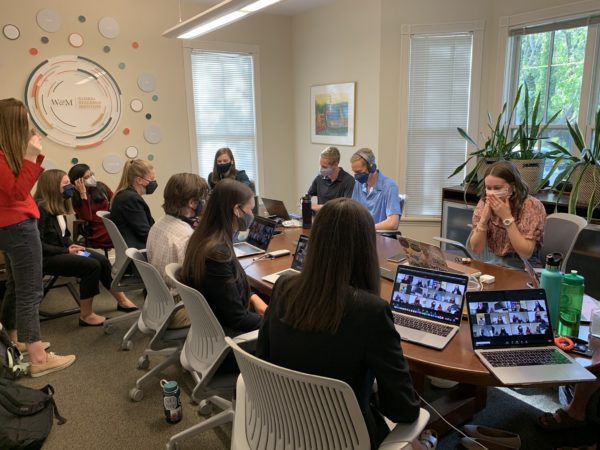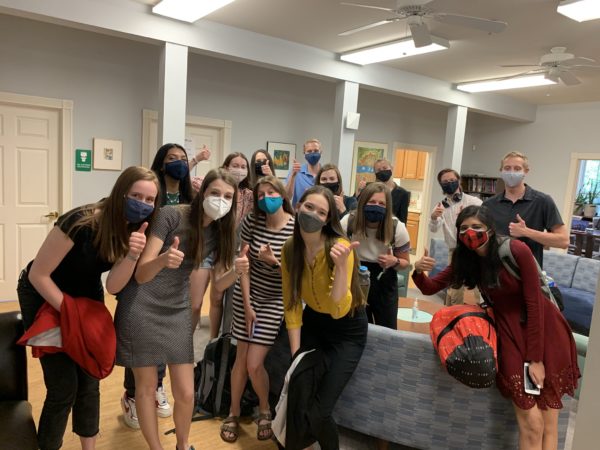Six International Security Challenges, Six Solutions: 2021 PIPS Symposium
Fellows at GRI’s Project on International Peace and Security (PIPS) participated in two virtual symposiums this year — first to the campus community on April 27 and then to a wider audience of scholars, members of the military, and policymakers on May 12. In both events, Lauren Boyes ’22, Nitya Labh ’22, Amelia Larson ’21, Morgan Pincombe ’21, Sania Shahid ’22, and Selene Swanson ’22 outlined solutions to pressing global challenges. Read on for a recap of this year’s events and for links to the full policy white papers.

PIPS Research Interns watch their fellows virtually present policy white papers at this year’s campus symposium.
Throughout the year, PIPS Fellows identify emerging issues in international security and work with Co-Directors Dennis Smith and Amy Oakes — both professors in the government department — to develop strategic responses. Along the way, they also receive expertise from military fellows, who offer subject-matter expertise and mentorship.
The second installment of this year’s event featured Fiona Hill — senior fellow at the Brookings Institution and former deputy assistant to the president and senior director for European and Russian affairs on the National Security Council — as a discussant.
“This has been a fascinating set of presentations,” Hill said. “There’s been quite some revelations here.”
The presentation topics and recaps are as follows:
“Where Do We Go Now? Satellite Imagery and GIS for Sustainable Relocation” by Lauren Boyes (pdf)
In focusing on those who have been displaced because of climate change, Boyes suggested partnerships with low- and middle-income countries to promote data-driven relocation. Geospatial technology, she explained, could offer valuable information that allows for well-planned, sustainable relocation practices.
“The international community needs an international leader on climate assistance,” she said. “The United States can be that leader.”
Climate displacement is expected to swell slum populations by 700 million people over the next ten years, she said.
“This will force groups to vie for increasingly scarce resources,” she said. “But this scenario does not have to become a reality.”
“Geographic Revisionism: Chinese Land Reclamation and Ambitions in the Southwest Pacific” by Nitya Labh (pdf)
Labh addressed China’s economic leverage over Pacific Island countries (PICs), as China helps these countries combat land loss.
“PICs are the most vulnerable countries in the world to sea level rise,” Labh said. “Migration is not an option for Pacific Island Countries.”
By assisting PICs, China gains economic leverage over these countries, allowing China to gain power in the Pacific Islands, she said. Labh suggested a US approach of limiting Chinese land influence, conducting regional monitoring, and helping with competitive island building.
Hill proposed that Boyes’s and Labh’s work could supplement one another.
“I was very struck, as I’m sure everyone else was, by the alternative variance of how one deals with climate change in small islands,” Hill said. “The implications and long-term climate effects of Chinese intervention seem pretty evident.”
“Casting a Neocolonial Net: China’s Exploitative Fishing in the Gulf of Guinea” by Morgan Pincombe (pdf)
Pincombe explained how the unequal contracts China draws through its Belt Road Initiative can result in unstable and inflated debt for African countries, which may lead to the seizure of strategic resources and the reinforcement of corruption.
“China compensates the Gulf of Guinea countries for only about four percent of the fish it extracts,” Pincombe said.
Pincombe’s policy solution involves mitigating destabilization, managing China’s influence, and developing a model to counter China.
Hill said Pincombe’s work could merge with Boyes’s and Labh’s to have even more varied applications.
“The three of you … have the opportunity to really write something here and take the show on the road and give a presentation to some of our colleagues — not just at the State Department, but also at places like the World Bank,” she said.
“From Singalongs to Spheres of Influence: How Russia Exports Patriotic Military Education to Post-Soviet Youth” by Amelia Larson (pdf)
Larson examined Russian military youth education camps, which rely on conservative values and promote militaristic Russian views — in Russia, in contested zones, and beyond. Overall, these youth education camps can increase Russia’s international control and influence abroad, spreading neo-Soviet and militaristic ideologies.
“The US has several options to respond, and it must work with its partners to push back on this rise of Russian youth militarization,” Larson said.
Larson’s solution involved pursuing monitoring approaches, information-sharing in contested zones, and offering legal assistance to allies to prevent youth participation.
Hill said Russia’s effort to target the camps in disputed territories was a key part of Larson’s considerations.
“Loose Links Sink Ships: Opportunities in the World of Online Piracy” by Sania Shahid (pdf)
Internet piracy — publishing content on unregulated or underregulated sectors of the internet — can actually be used advantageously by advocacy organizations, Shahid explained. This is especially the case in countries where free speech is limited.
“[Piracy] is unlikely to disappear due to the nature of digital technology,” Shahid said, referring to the immense profit people can make from engaging in piracy.
Shahid proposed that civil society organizations should use material on piracy platforms to promote human rights, provide public service information, create spaces for dissent, and explore advocacy through entertainment.
Hill suggested that the shifting media landscape offers new avenues for news to be disseminated.
“You talked about a really clever way of using piracy for advocacy,” Hill said. “This is a way of getting different messages to people. It’s a really creative way of getting out the old-school public service announcements.”
“By the People: The Role of Local Deliberative Forums in Combating Affective Political Polarization” by Selene Swanson (pdf)
Swanson brought the scope of the presentations back home by looking at political polarization in the US, which has been escalating for years. Swanson said this continued rise could have disastrous consequences and empower foreign disinformation.
“The data shows the US is polarizing more quickly than other developed democracies and is beginning to resemble developing democracies, like Poland,” Swanson said.
Swanson’s response involved promoting community forums, and her research showed that contact can reduce prejudice.
Hill connected Swanson’s topic to Larson’s, suggesting that the two could fortify one another.
“Putin likes to exploit polarization when it’s outside of Russia, but inside of Russia, he likes to have the exact opposite,” she said. “He wants to have a much more synthetic, pulled-together, unified culture.”
As Larson’s project examined youth groups, Hill had an idea for Swanson’s: Youth may serve as mentors for other generations by demonstrating open-mindedness and eagerness to learn.

PIPS Fellows and interns pose for a photo together after a successful campus symposium.



No comments.
Comments are currently closed. Comments are closed on all posts older than one year, and for those in our archive.